Here I am in West Sumatra with Trees and while we have only seen such a teeny, tiny part, we are totally smitten! 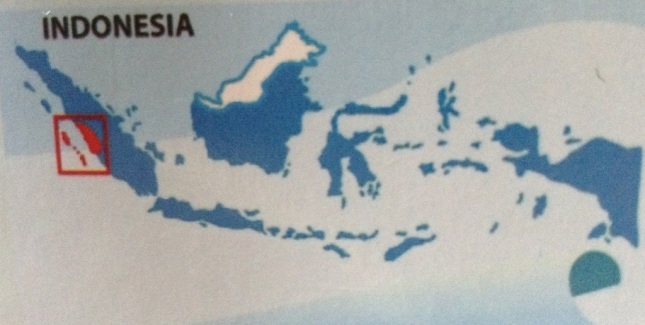 Indonesian Map with West Sumatra marked in red. The western islands are the famous Mentawai’s.
Indonesian Map with West Sumatra marked in red. The western islands are the famous Mentawai’s.
 Map of Sumatra showing where Padang & Bukittinggi are on the island.
Map of Sumatra showing where Padang & Bukittinggi are on the island.
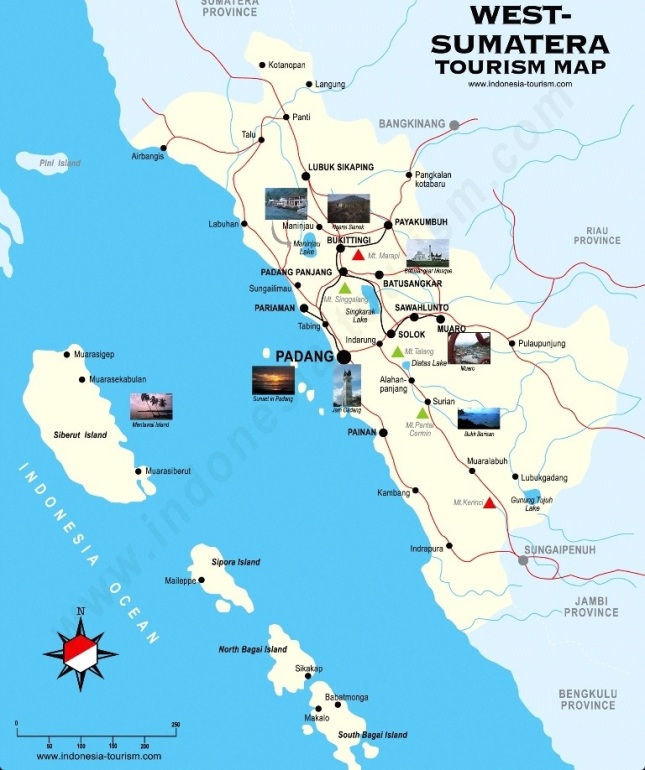 Map of West Sumatra which hopefully you can refer to as you read through this post.
Map of West Sumatra which hopefully you can refer to as you read through this post.
We arrived in Padang on Friday night after a horrendous and nerve wracking trip to the airport in Jakarta. The driver we booked to take us to the airport recommended picking us up at 4pm for a 6:30pm flight. Bu Valentina was rightly skeptical that we could make it to the airport in time especially considering it was Friday afternoon. Sure enough and totally unsurprisingly, the traffic was terrible. We inched forward ever so slowly and even though we went from Bu Valentina’s house in Tanggerang to the airport which is on the other side of Tanggerang, a half hour journey took 2.5 hours! As we were being driven along, we texted Bu Valentina updates on our location and it was incredibly stressful watching time pass while we were helplessly stuck in traffic. Eventually we entered the main entrance into the airport and we started to breathe easily as it was 6:10 and check in closed at 6:15. We thought we would just make it and then , can you believe it, we hit another traffic jam! We watched our watches in dread as 6:15 passed and we were just starting to plan what we would do now that we had surely missed the flight when a very welcome text from Bu Valentina arrived saying that the flight had been delayed! I have never been so thrilled on hearing that my flight has been delayed! The traffic finally started moving and we finally reached the terminal. We flew out of the car, grabbed our bags and literally pushed our way through the lines of people waiting to get through the doors to where the luggage was being x-rayed. Every queue we came to, we pushed to the front and it was with relief we finally got to the ticket desk and were told that we could still check in. Once getting our boarding passes, we raced upstairs to the boarding lounge where Bu Valentina greeted us with the news that the plane had been further delayed and wasn’t now due till 8pm. It was so bizarre to be able to finally stop and breathe easily. 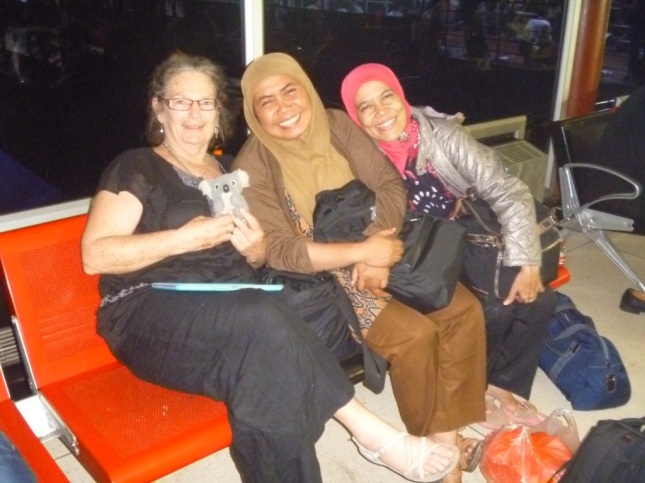
I enjoyed having the time to go back outside to the ATM, go to a shop and buy some bottles of water and find a toilet. The plane was later further delayed and we finally boarded at 9pm. Whereas normally such a long flight delay would be incredibly annoying, I was still so relieved that we hadn’t missed the flight, I didn’t care.
We arrived in Padang around 10:30pm 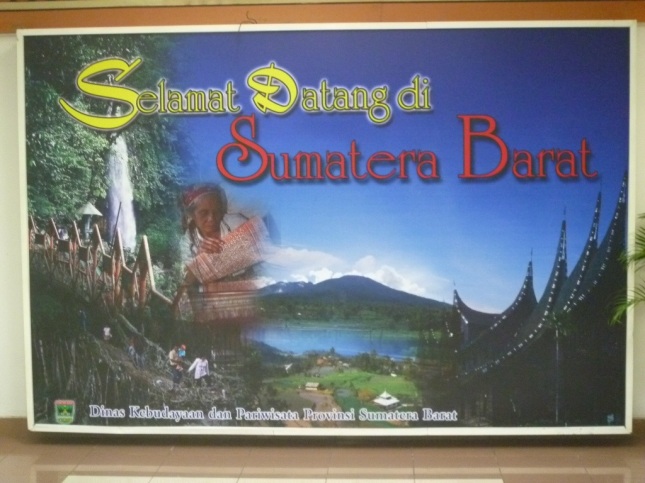 however it was midnight before we finally crashed into bed because there was a mix up at the hotel as the staff had given one of our rooms to someone else, so there was a last minute delay while a replacement room was prepared. Bu Valentina said that is the last time she will make a booking in West Sumatra using Indonesian! Next time she will use Bahasa Padang (Padang language) so they know she is a local!
however it was midnight before we finally crashed into bed because there was a mix up at the hotel as the staff had given one of our rooms to someone else, so there was a last minute delay while a replacement room was prepared. Bu Valentina said that is the last time she will make a booking in West Sumatra using Indonesian! Next time she will use Bahasa Padang (Padang language) so they know she is a local!
We woke up early the next morning so that we could get a full day of sight seeing in before arriving in Bukittinggi. After a quick breakfast, we headed out and did some local sight seeing. We drove through the old part of the city (Kota Tua) which is now largely occupied by Chinese traders. The buildings date back to Dutch colonisation and look very solid however there were gaps where several were damaged in recent earth quakes and haven’t yet been rebuilt.
The following is an excerpt from Wikipedia about the 2009 earthquake:
The September 2009 Sumatra earthquake occurred just off the southern coast of Sumatra, Indonesia. The major shock hit at 17:16:10 local time on September 30, 2009 and had a moment magnitude of 7.9. The epicenter was 45 kilometres (28 miles) west-northwest of Padang, Sumatra, and 220 kilometres (140 miles) southwest of Pekanbaru, Sumatra. Early death-toll estimates extended beyond 1300. Government reports have to date confirmed 1,115 dead, 1,214 severely injured and 1,688 slightly injured. The most deaths occurred in the areas of Padang Pariaman (675), Padang (313), Agam (80) and Pariaman (37). In addition, around 135,000 houses were severely damaged, 65,000 houses were moderately damaged and 79,000 houses were slightly damaged. An estimated 250,000 families (1,250,000 people) have been affected by the earthquake through the total or partial loss of their homes and livelihoods.
We saw evidence of the earthquake all through West Sumatra but no more so than in Padang. The rebuilding of Padang still continues today and many of the buildings are being rebuilt with foreign aid for which the local people are immensely grateful. Bu Valentina often pointed out a new building and could name exactly which nation had contributed to it’s rebuilding! It was a great feeling when she showed us a building rebuilt with Australian monies!
Other sights we saw in Padang included the Siti Nurbaya Bridge which crossed the Harau River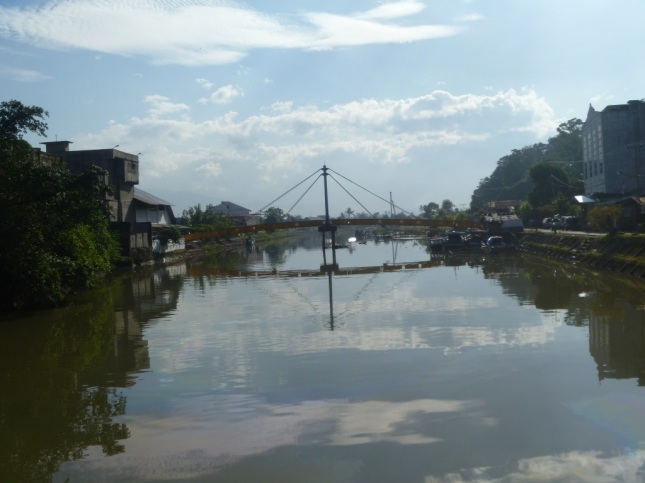
a suspension bridge (Jembatan Gantung)
a local park complete with the first ever plane that flew into Padang (also the one that Bu Valentina’s father flew into Padang on)
and a traditional Padang house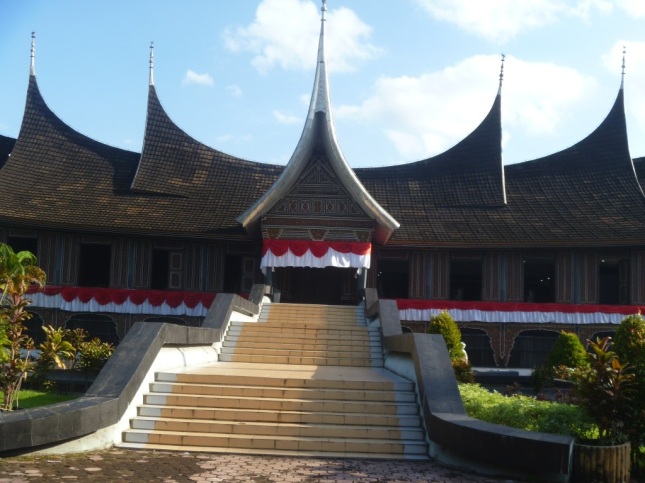
and then briefly to Bu Valentina’s sister’s house where we dropped in for a cup of coffee before beginning our long drive to Bukittinggi.
In Padang we noticed many government offices with the traditional buffalo styled shaped roof as well as many really old houses also with the buffalo horn styled rooves. Up until the recent earthquake, it was mandatory for government offices in West Sumatra to have a traditional styled roof however now with the emphasis being rebuilding, building regulations are temporarily waived.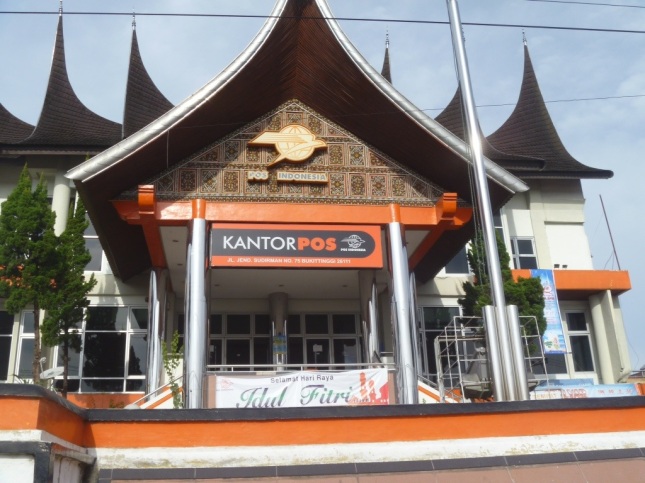
The road out of Padang was very windy and steep with breath taking views from both sides of the car. One section of the road was in the process of being repaired and thankfully we only had a short wait before getting passed however on the other side, the queue of vehicles went back for kilometers and apparently some vehicles wait over an hour to get passed. We passed many tea plantations which were fascinating with their very low to the ground bushes planted in rows. Only saw a couple of tea pickers though!
We stopped for lunch at a Padang Food restaurant high up in the hills with the most amazing views however none of my photos did it any justice! Weirdly, the most interesting thing about this restaurant was the toilet. It was down a steep set of stairs and out the back, surrounded by a low brick wall. 
This is the women’s toilet and as you can see, there is a large open space with several squat toilet bowls built into the floor around the edges with a wide channel behind them for sluicing. The water for sluicing comes from the huge tank in the back ground. The sluiced water then follows the open channel and goes outside under the wall. I started tracking the channel but lost sight of it when it went over the hill. Probably channeled to a nearby river.
Across the road was a traditional styled house used as a meeting hall for the local village. Isn’t it beautiful.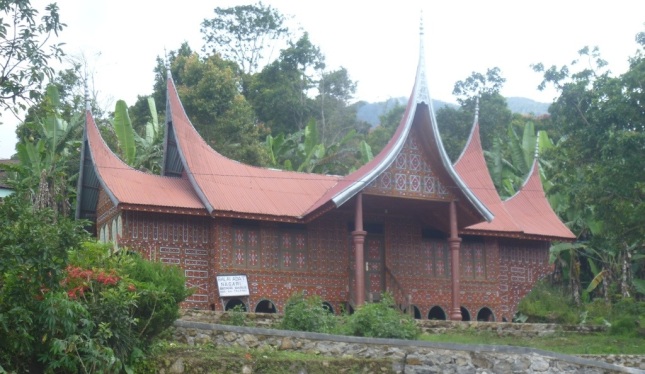
Our next stop was at one of 2 lakes. The first one is known as Danau di Atas (The Top Lake) and while the lake itself was very impressive, the surroundings were the total opposite. The grounds were neglected and rubbish was strewn everywhere. We found it hard locating the track down to the lake and it was by chance that we finally stumbled upon some steps leading down to a crumbling path overgrown with huge grass which apparently is used for weaving, however this grass has obviously yet to be discovered by any weavers! Bu Valentina & Bu Yanti were disgusted too by the state of the grounds and were equally happy not to spend any time there once we had taken our photos. We then headed up to Danau di Bawah (The Bottom Lake) however didn’t reach the lakeside, just found a rocky track from where we enjoyed the view. While taking photos, several trucks laden with onions (eschalots) passed us.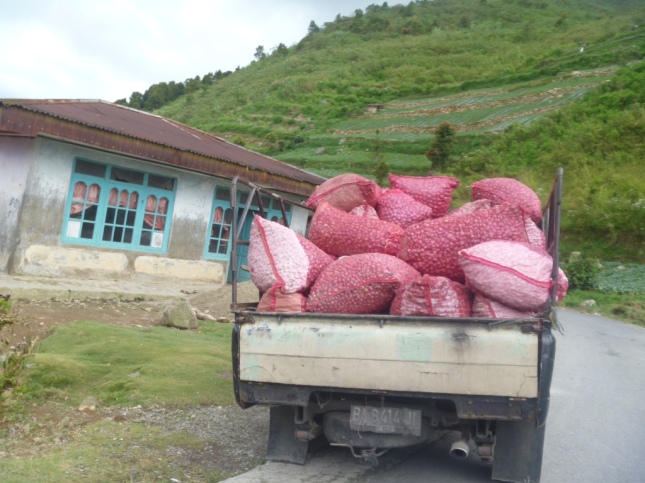
As onions are very expensive all over Indonesia at the moment, we dropped in on an onion farmer on our way back along the track. Inside a small hut, onions were waiting to be bagged and taken to market. Bu Valentina told us that Indonesian onions are largely exported and Indonesians eat onions from Bangkok! So, Bu Valentina was keen to see if she could buy some locally grown onions which would make great oleh oleh for friends and family. The farmer didn’t have any scales, so he just bagged them in a plastic bag and charged Bu Valentina next to nothing. He was amazed to see 2 white travelers with them and must have been skeptical of Bu Valentina’s claim that we were both Indonesian teachers. Suddenly she ordered me to interview the onion seller to demonstrate that I did indeed speak Indonesian. As her initial conversation had been In Bahasa Padang, I had no warning this was about to happen and so the first thing I could think of was to ask the onion farmer was how long it took for an onion crop to grow before it is harvested. Apparently it takes 6 months! I was a bit stumped thinking about another question, and of course later thought of several great questions I could have asked him!
Instead of retracing our steps to Lubuk Sulasih, our driver, Yanto, took a back road towards Batu Sangkar via Danau Singkarak, the 2nd largest lake in Indonesia after lake Toba. Along the edge of the lake were many warungs all selling bulk quantities of krupuk and dried fish.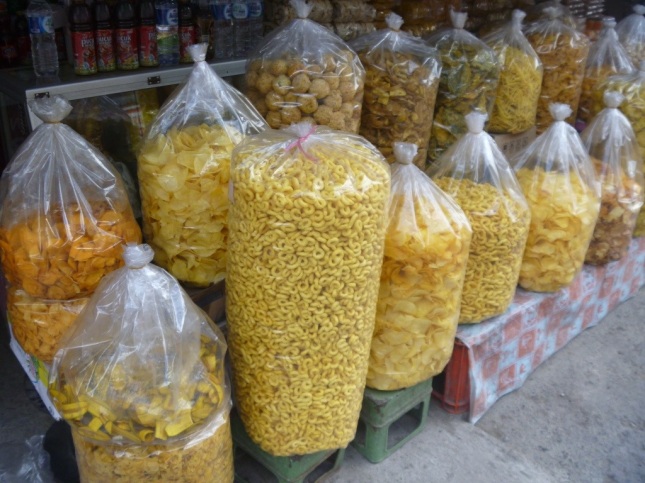
What grabbed my eye was the dried eels.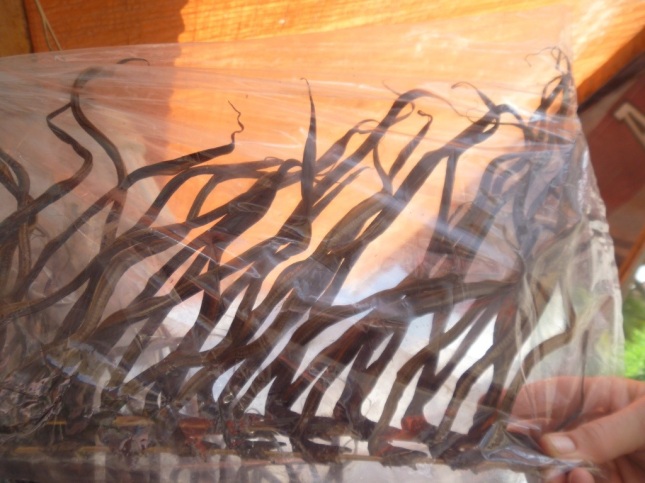 They look like mermaid hair!
They look like mermaid hair!
After Bu Valentina had bought a bag of dried fish, I noticed that behind the warung were drying racks covered in fish sliced in half. 

Batu Sangkar is a town where visitors can walk around a Sultan’s Residence. On the drive there, Bu Valentina retold us the ‘true’ version of the Minang Kabau legend which explains why all houses here have buffalo horn shaped rooves.
A very powerful kingdom in Java, Singosari, sent a royal prince to be married with one of the princesses from Sumatra. After the marriage, the Singosari Kingdom demanded that West Sumatra join the Singosari Kingdom which naturally, was not something the Sumatrans wanted to do. So they instead proposed a buffalo competition with the winner holding peaceful sovereignty of West Sumatra. The Javanese Prince agreed and immediately returned to Java to search for the strongest & fiercest buffalo whereas the Sumatrans located a calf and for a week before the competition they separated it from its mother and on the day of the competition they attached very sharp knives to the top of its head. The Javanese Prince and his entourage were puzzled when into the ring, the calf arrived to ‘battle’ against their buffalo. The buffalo too was puzzled, however the calf in his hunger, thought it was his mother and raced over to the bull and tried to nuzzle the bull looking for something to eat. In doing so, the sharp knives attached to the calf’s head killed the buffalo. Thus with cunning and skill, the Sumatran’s won the competition and from that point onwards, houses in West Sumatra have been built with the distinctive buffalo horn shaped rooves.
The palace was beautiful with ornately carved exterior walls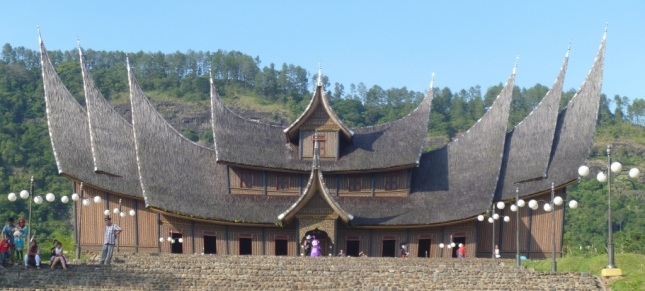
woven rattan walls on the back and side walls.

After walking around the kraton, we visited the grave yard where the sultans and his family have been buried over the years.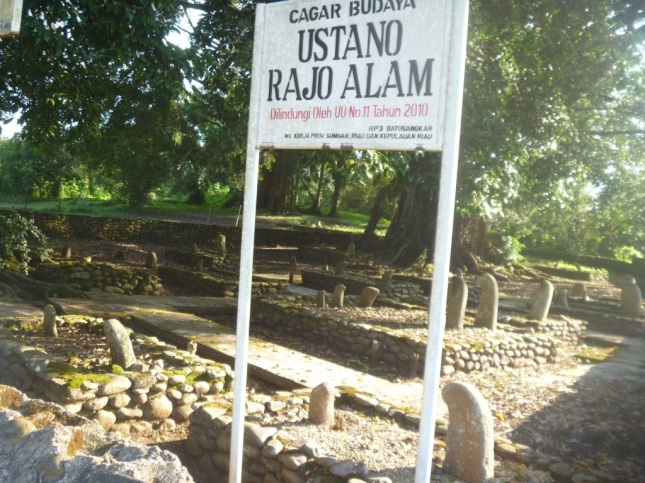
By this time, it was time for 3pm prayers for Bu Valentina, Bu Yanti and Yanto, so we stopped at a beautiful looking mosque. It was quite warm, so Trees and I also washed our feet, face and hands in the washrooms. Before praying, Muslims must wash (berwhuduk)  so mosque bathrooms have a wall of taps where this can be done. I felt so refreshed afterwards.
so mosque bathrooms have a wall of taps where this can be done. I felt so refreshed afterwards.
As it was now getting towards late afternoon, we headed straight to Bukittinggi. On the outskirts was a coffee house selling a type of coffee with a very sad history. During the Dutch colonisation, Indonesians were forbidden to drink coffee made from coffee beans, so they developed a way to manufacture coffee from coffee leaves and it is known as kopi kawa. We stopped at a coffee house which looked out over rice fields so that Trees & I could try it. The coffee was served in half coconut shells and while very distinctly coffee flavored, there was an unusual bitterness which I was able to mask by adding lots and lots of sugar!  The coffee came with delicious macaroon style cakes called bika. Bika are cooked between 2 heat sources and so were deliciously crispy on the outside and crumbly in the middle. I wonder how the caffeine levels of kopi kawa compare with ‘real’ coffee? It certainly didn’t keep us awake but that may be more to do with the fact that we were so tired after so much traveling!
The coffee came with delicious macaroon style cakes called bika. Bika are cooked between 2 heat sources and so were deliciously crispy on the outside and crumbly in the middle. I wonder how the caffeine levels of kopi kawa compare with ‘real’ coffee? It certainly didn’t keep us awake but that may be more to do with the fact that we were so tired after so much traveling!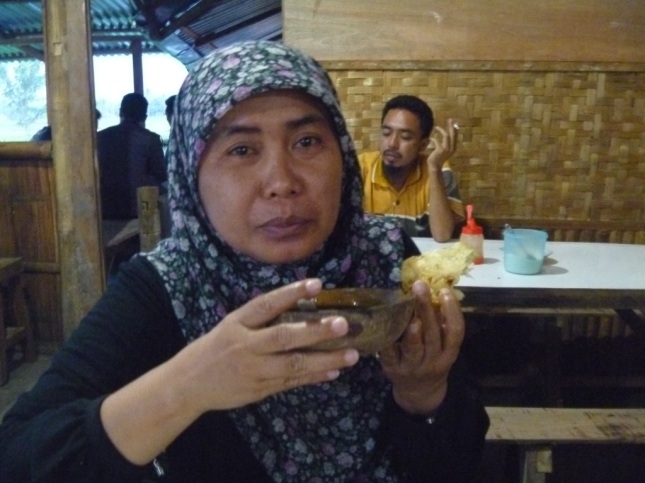
Our hotel in Bukittinggi was average even if the price was way above however it was still lovely to stop and relax for a while. Bu Nani, Bu Valentina’s sister, was waiting for us and it was great to see her again with her son, ‘Dik. Later after a delicious meal of cap cai, we were taken out for a walk to the main square where the Jam Gadang is located. 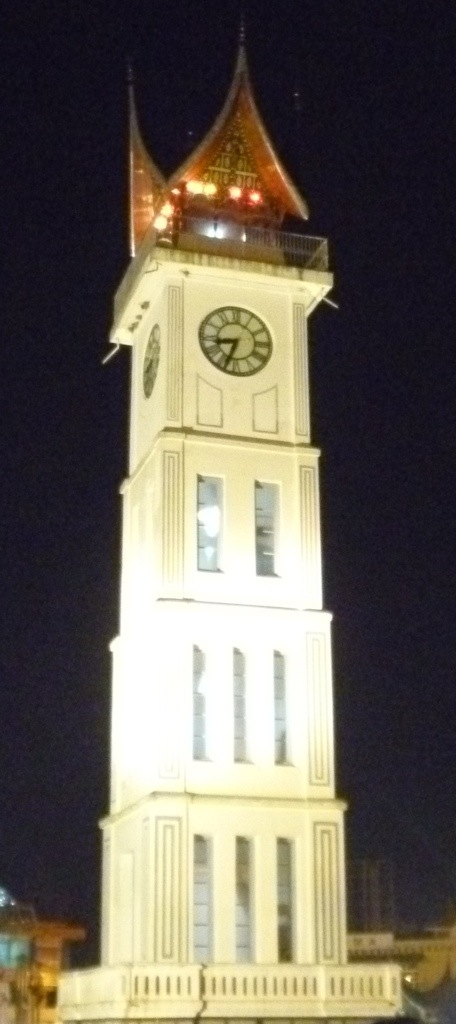 The clock was built in 1926 by an Indonesian architect whereas the clock machinery was donated by the then Queen of Holland. At first the roof of the clock was a dome with a rooster statue above it which somehow told people the time if they couldn’t read a clock face. During the Japanese occupation, the roof was altered and then after Indonesian Independence, the roof was again altered to reflect the Minang Kabau culture. While taking our photos, it began to rain lightly, so we called for Yanto to bring the car closer and we then headed off to the night market to buy some durian. We stood under umbrellas in the drizzling rain eating durian which the seller opened once the haggling was done. These durian were smaller than the ones I have tried in Kalimantan and were bitter; I was so disappointed. After Bu Valentina’s sister, Nani, had eaten her fill, we headed home to bed. I was so tired that I was totally oblivious to the constant noise of traffic on the nearby street however the others did not sleep so well. The benefits of being a heavy sleeper.
The clock was built in 1926 by an Indonesian architect whereas the clock machinery was donated by the then Queen of Holland. At first the roof of the clock was a dome with a rooster statue above it which somehow told people the time if they couldn’t read a clock face. During the Japanese occupation, the roof was altered and then after Indonesian Independence, the roof was again altered to reflect the Minang Kabau culture. While taking our photos, it began to rain lightly, so we called for Yanto to bring the car closer and we then headed off to the night market to buy some durian. We stood under umbrellas in the drizzling rain eating durian which the seller opened once the haggling was done. These durian were smaller than the ones I have tried in Kalimantan and were bitter; I was so disappointed. After Bu Valentina’s sister, Nani, had eaten her fill, we headed home to bed. I was so tired that I was totally oblivious to the constant noise of traffic on the nearby street however the others did not sleep so well. The benefits of being a heavy sleeper. 
Our next day in Bukittinggi started with a tour of Bung Hatta’s house where he grew up. Here is what you get if you google Bung Hatta: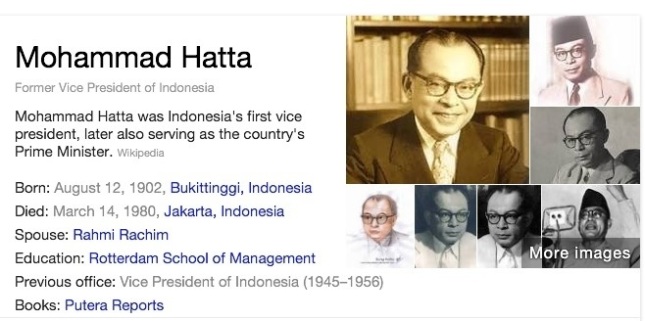 Being the first vice president after independence, he is very well loved and fondly remembered, as is Bung ‘Karno, the first president. This house is one of only a few museums I have ever visited in Indonesia which has been so beautifully maintained. The furniture was polished till it shone and everything was spotless. It was very impressive and we could feel the history around us.
Being the first vice president after independence, he is very well loved and fondly remembered, as is Bung ‘Karno, the first president. This house is one of only a few museums I have ever visited in Indonesia which has been so beautifully maintained. The furniture was polished till it shone and everything was spotless. It was very impressive and we could feel the history around us. 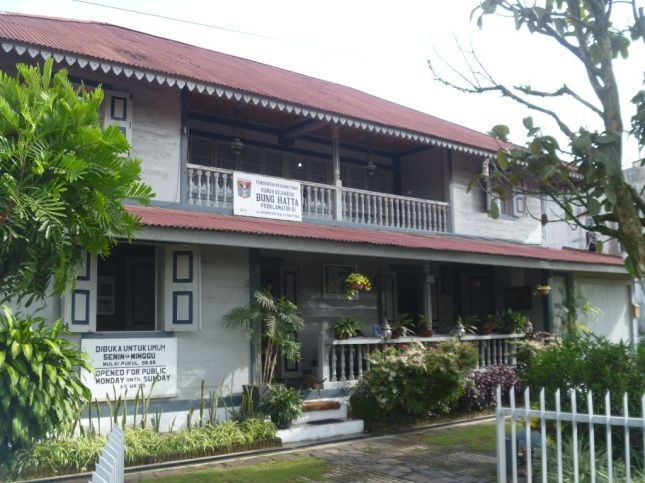
 Can you see a tiny leg lifted above one of the pillows? This is what is behind the pillows!
Can you see a tiny leg lifted above one of the pillows? This is what is behind the pillows! I just loved this house as every part of the house has been lovingly looked after and we had great pleasure commenting about it in the visitors book!.
I just loved this house as every part of the house has been lovingly looked after and we had great pleasure commenting about it in the visitors book!.
From this house, we were taken to the pasar tua (old market) where we saw an interesting sight on our way to get our lunch. Can you see what they are?  Painted hermit crabs!
Painted hermit crabs!
We were further distracted by the shoe stalls where Trees bought a pair of hand made calf leather shoes for Rp15,000 (AUD$3). Unfortunately I missed out because there were none my size!
We then each bought a skirt before heading to where the food stalls are. There we had fun choosing what we wanted for lunch and watching how the lady put our nasi bungkus (take away rice packets) together.
She first took a square of banana leaf and put it on top of a slightly larger square of brown paper. This was then shaped into a large open cone and into that she put a large amount of white rice, sambal, a beautiful potato rendang, and then for the meat eaters a beef based dish was also added. These were sealed up with a toothpick. She then used a plastic bag and the incredibly long spoon that is in the front dishes of food to fill up the bags with the food that we each chose to eat with out nasi bungkus. This type of nasi bungkus is called ‘nasi kapau’ in Bukittinggi. 
Once our lunch was organised, we headed across the road to the Kinantan Zoo where there were all sorts of animals even a small kangaroo! As Bu Valentina & Bu Yanti had a flight home to catch, we were all conscious of the passing time and tried not to dilly dally too long there. We walked quickly through the zoo to a suspension bridge connecting it to Fort De Kock, a Dutch fort built in 1825.
Yanto collected us once we had emerged from the fort where Trees and I photographed a very unusual yet attractive bird. 
and we headed to Lakle Maninjau via some spectacular scenery.
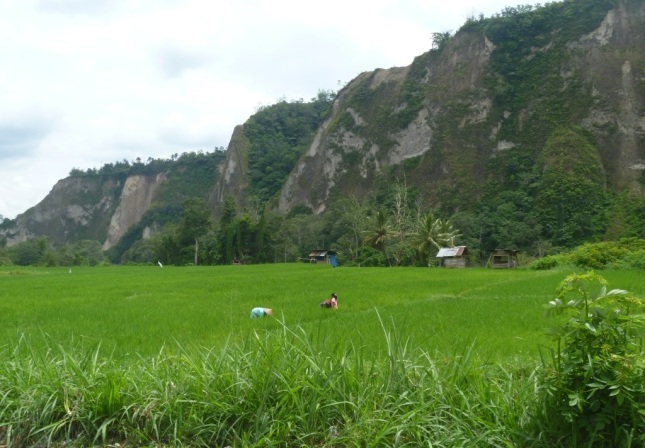
Along the roadside were all sorts of beautiful plants growing wildly including lavender, dahlias, wild orchids, cinnamon trees, a yellow daisy and cats whiskers were some of the ones I could identify.
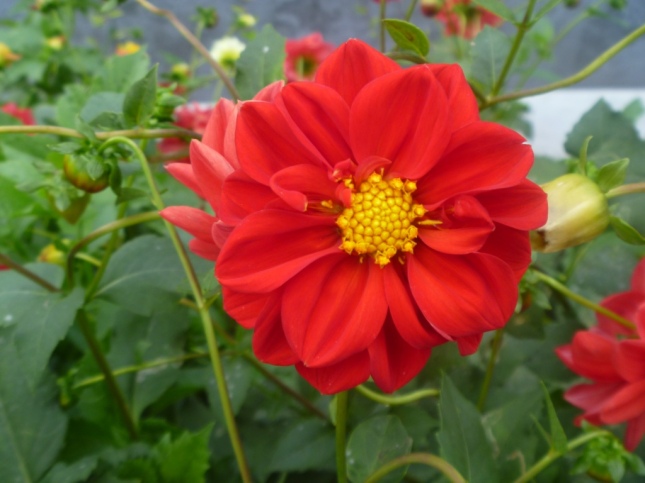
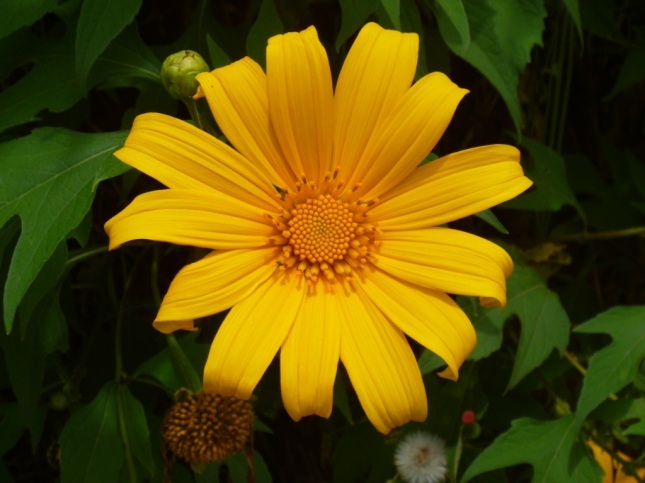
We reached a place called Embun Pagi which literally means ‘Morning Dew’ and from there we looked down onto Lake Maninjau. While the view over the lake was spectacular, it would be even more impressive on a sunny day. From this point, our descent down to the lake went along the famous road known as ‘Jalan Kelok 44’ meaning the road with 44 hairpin bends and each hairpin was numbered!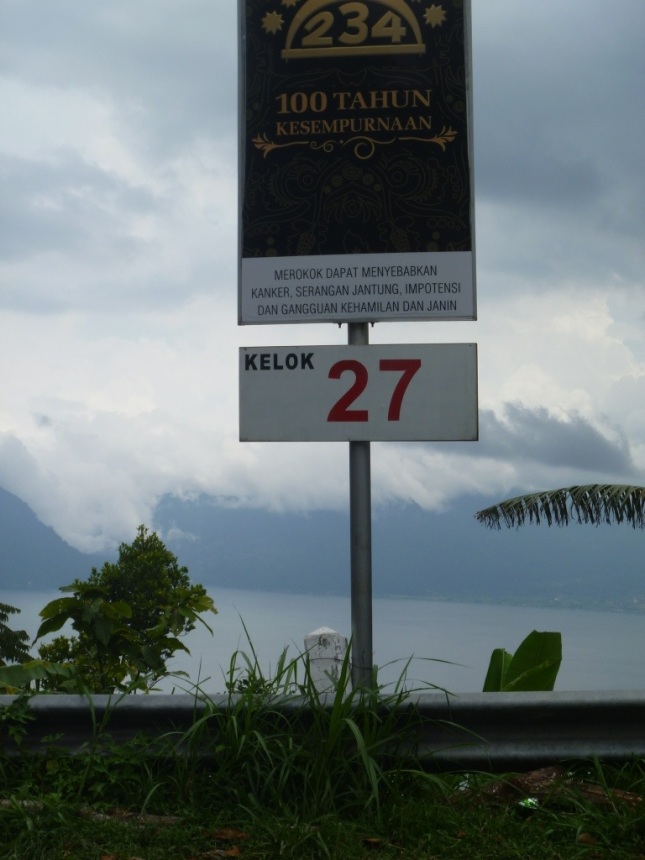
It made the 7km descent fun as we counted down the hairpins! At one point, we came across a few monkeys sitting on the rails. They looked a similar breed to the ones found at the monkey forest in Bali. We drove around the lake until we found a secluded balai by the waters edge and there we unpacked our delicious lunch and feasted.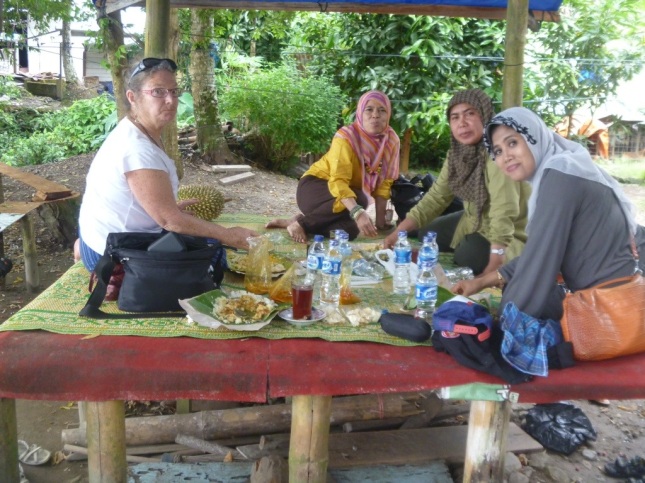
Young men were fishing from the edge of the lake and out in the water were fish farms and it was very picturesque. We enjoyed the view while feasting on an enormous and deliscious durian which thankfully tasted nothing like the ones from the previous evening.

It was time for midday prayers, so we headed to a nearby mosque. Trees and I felt very honoured to be invited into the mosque where we sat on a large mat at the back while a small group of people prayed in front of us. Surprisingly the men and women weren’t divided by a screen as it is usually done, however they did sit apart. The women sat in a line across the back of the prayer area to pray and after they had finished praying, remained seated and then with the help of a small compact mirror, repaired their makeup which had been washed off in the pre prayer wash. The men though after praying, moved into a small circle and chatted. Being the first time ever witnessing muslim praying in a mosque was very special.
After prayers, began the major trek back to Padang in time to put Bu Valentina & Bu Yanti on the plane back to Jakarta. We were making good time until they suddenly decided that we should stop off at a tiny village where there were several gold jewelry shops. While Trees & I sat in the car, they all had fun choosing a piece of jewelry and then having greater fun bargaining to get the best price. They were all delighted with the rings they each bought however it put a lot of pressure on Yanto to get us back to Padang in time for the Jakarta flight. We raced back to Bu Nani’s house where all the oleh oleh were boxed up ready for the plane and then we zipped over to the airport where once again I had a giggle to myself that I, the Aussie traveller, farewelled Indonesian tourists instead of the other way around! They made the flight in good time while we went home to bed relieved only to discover the next morning that their flight had been delayed till 3am and once they had arrived in Jakarta, they had to head straight to school! Poor Bu Yanti had a full day of lessons so it would have been a very long day for her in particular.
What a wonderful introduction to Sumatra and if West Sumatra is anything to go by, I am definitely keen to return and do a lot more exploring.
Hi Cathy and Trees,
Thank you for such a comprehensive account of this part of your journey and my stomach was in knots reading your trip to the airport especially being in the same situation once in England but we had a 2year old and a 6th month old with us and thinking we had missed the flight and how were we ever going to afford more flights and the shear relief that the flight had been delayed 3hours. wow breath free. What an amazing trip you are on, once in a life time. Thanks for sharing, stay safe. Love Anne